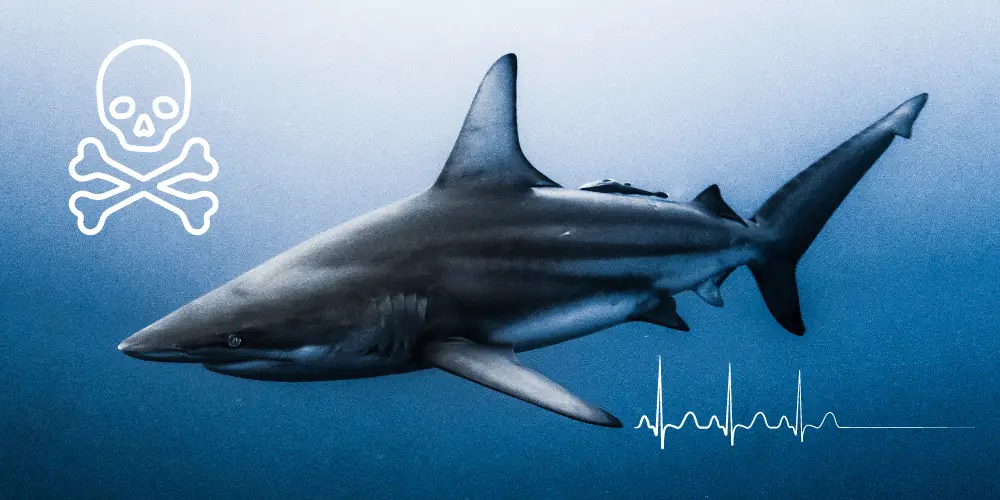When it comes to the vast and mysterious ocean, few creatures capture our imagination and fear, like sharks. If you’ve found yourself here, you’re likely asking, “Are bull sharks dangerous?”
Bull Sharks are among the most dangerous sharks due to their aggressive behavior and preference for shallow waters, increasing human interactions. Between 2017 and 2022, International Shark Attack File (ISAF) reported that bull sharks were involved in 119 incidents: 93 unprovoked bull shark attacks, with 26 being fatal.
Let’s dive deep into the waters of understanding and uncover the truth behind the myths.
Key Takeaways
- Bull sharks are known for their aggressive behavior and preference for shallow waters.
- Between 2017 and 2022, ISAF reported 119 incidents involving bull sharks, 93 unprovoked attacks, and 26 fatal.
- Bull sharks have historically been a focal point in discussions about dangerous marine animals.
- Their aggressive reputation is based on actual incidents and observations, not hearsay.
- Bull sharks can thrive in salt and freshwater, leading to unexpected human encounters.
- Media often sensationalizes shark attacks, which can skew public perception.
- Bull sharks play a significant role in maintaining the balance of marine ecosystems.
- Understanding and respecting bull shark behavior can reduce potential risks to humans.
- Many shark attacks, especially by bull sharks, are believed to be cases of mistaken identity.
- Conservation efforts for bull sharks are crucial, given their role as keystone predators in marine ecosystems.
Bull Sharks’ Dangerous Reputation
The question, “Are bull sharks dangerous?” is not new.
Bull sharks have been at the forefront of discussions about dangerous marine animals for decades.
Their reputation is not solely based on hearsay or fictional tales but is rooted in incidents and observations.
Historical Context
Bull sharks have been implicated in many shark attacks throughout history.
While the Great White Shark often steals the limelight in media, bull sharks have been responsible for many attacks near shorelines.
Their ability to thrive in salt and freshwater means they can be found where people least expect them, leading to unexpected encounters.
Unpredictable Nature
Bull sharks are considered dangerous because of their unpredictable behavior.
Unlike other shark species that might be more cautious or timid around humans, bull sharks are known for their boldness and can be aggressive when provoked or even without provocation.
Territorial Behavior
Bull sharks are territorial creatures. They might react aggressively when they feel that their territory is being invaded.
This territorial nature, combined with their frequent presence in populated areas, can lead to confrontations with humans.
Mistaken Identity
Many attacks on humans are believed to be cases of mistaken identity.
Bull sharks, while hunting for prey, might mistake a human for a seal or other marine animal.
The murky waters near beaches or river mouths can make it difficult for them to differentiate, leading to accidental attacks.
Media Influence
It’s also worth noting that the media plays a significant role in shaping the reputation of bull sharks.
While any shark attack is undoubtedly tragic, the media often sensationalizes these events, leading to heightened fear and misconceptions about these creatures.
The reputation of bull sharks as dangerous predators is not entirely unfounded; it’s essential to approach the topic with a balanced perspective.
Recognizing the reasons behind their behavior and understanding the context of their interactions with humans can provide a more nuanced view of these magnificent marine animals.
Bull Sharks’ Attacks Statistics
From the International Shark Attack File (ISAF), here are the statistics from 2017-22 specifically for bull sharks:
- Species: Bull Shark (Carcharhinus leucas)
- Confirmed Unprovoked Attacks: 93
- Fatal Attacks: 26
- Total Incidents: 119
Over the last decade, Australia has documented 16 bull shark incidents, two being fatal.
It’s important to note that the identification of attacking sharks is challenging.
Victims rarely have the opportunity to observe the attacker closely during the incident.
The tooth remains, which could help identify, are seldom found in wounds. Moreover, many sharks, especially those in the Carcharhinidae family (requiem sharks), are difficult to distinguish, even by professionals.
The bull, white, and tiger sharks are often called the “Big Three” in the shark attack world .
They are large species capable of inflicting serious injuries, are commonly found in areas where humans enter the water, and have teeth designed to shear rather than hold.
Bull Sharks Biology and Characteristics
Bull sharks, scientifically known as Carcharhinus leucas, are among the most fascinating species in the shark family.
Their unique biological features and adaptability set them apart from other marine creatures.
Physical Features
Size
Adult bull sharks typically measure 7 to 11.5 feet in length, with females generally larger than males.
They can weigh anywhere from 200 to 500 pounds, with some exceptional individuals exceeding this range.
Color
Their coloration is unique, with a greyish top that helps them blend into the ocean’s murky depths and a lighter underside, providing camouflage from predators and prey below.
Distinguishing Characteristics
One of the most distinguishing features of bull sharks is the absence of an interdorsal ridge between their two dorsal fins, a feature present in many other shark species.
Diet and Feeding Habits
Varied Diet
Bull sharks are opportunistic feeders. Their diet primarily consists of bony fish, but they’ve also been known to consume stingrays, smaller sharks, birds, and even terrestrial mammals when the opportunity arises.
Hunting Technique
They often employ a technique called “bump and bite,” where they first bump their prey with their snout to disorient it before going in for the bite.
Feeding Grounds
Bull sharks often hunt in shallow waters, which is one of the reasons they come into contact with humans.
Their preference for murky waters gives them an advantage when ambushing prey.
Adaptability
Osmoregulation
One of the most remarkable features of bull sharks is their ability to regulate their internal salt concentration.
This allows them to move seamlessly between saltwater and freshwater environments.
Freshwater Habitats
They are one of the few shark species found in freshwater systems. Bull sharks have been spotted in rivers and lakes, sometimes hundreds of miles from the ocean.
This adaptability has led to sightings in places like the Mississippi River in the U.S. and the Amazon River in South America.
Reproduction
Viviparous Breeders
Bull sharks are viviparous, meaning they give birth to live young. A female can have a litter ranging from one to thirteen pups after a gestation period of about 12 months.
Nurseries
After giving birth, the young bull sharks often spend their early years in freshwater systems, which offer protection from larger predators.
These areas serve as nurseries until the sharks are large enough to venture into the open ocean.
The biology and characteristics of bull sharks are a testament to their resilience and adaptability.
These features and their unpredictable nature contribute to the intrigue and caution associated with this species.
Bull Sharks’ Behavior and Habitat
Bull sharks are renowned not just for their adaptability but also for their aggressive nature.
This behavior, combined with their unique habitat preferences, makes them one of the ocean’s most intriguing and formidable species.
Aggressive Tendencies
Natural Instincts
Bull sharks exhibit aggressive behaviors often driven by territorial instincts, competition for food, or perceived threats.
Bump and Bite
Their hunting technique often involves a “bump and bite” strategy. This can be misinterpreted as aggression when a bull shark bumps a human, possibly out of curiosity or mistaken identity.
Test Bites
Many reported attacks involve a single bite, often called a “test bite.” While these bites can be severe due to the bull shark’s powerful jaws, they often don’t continue the attack afterward, suggesting a lack of predatory intent.
Habitat Preferences
Shallow Coastal Waters
Bull sharks are frequently found in shallow coastal waters, making them more likely to come into contact with humans than some other shark species.
Estuaries and River Mouths
They have a particular affinity for estuaries and river mouths, areas where saltwater and freshwater mix. These regions are rich in prey, making them ideal hunting grounds.
Freshwater Adaptability
Their unique ability to thrive in freshwater means they can be found far from the ocean, in rivers and lakes.
This adaptability has led to encounters in unexpected places, heightening their dangerous reputation.
Migration and Movement
Seasonal Migration
Bull sharks, like many marine species, migrate in response to environmental changes, such as temperature fluctuations or prey availability.
Long-Distance Travelers
They are known to cover vast distances during their migrations. For instance, bull sharks tagged in the Gulf of Mexico have been found as far away as the Atlantic coast of Florida.
Interaction with Humans
Increased Encounters
Due to their preference for shallow waters and ability to thrive in freshwater, bull sharks have more opportunities for human encounters than other shark species.
Unintentional Provocation
Activities like spearfishing can unintentionally provoke bull sharks. The wounded fish can attract sharks, and the erratic movement of the spear can be mistaken as a threat.
The aggressive behavior of bull sharks, combined with their unique habitat preferences, makes them a species of interest and caution.
While they are undoubtedly formidable, understanding their behavior and habitat can help foster a more informed coexistence between humans and these magnificent creatures
Comparison with Other Sharks
When discussing the danger sharks pose, it’s essential to understand how bull sharks stack up against other species.
While the Great White Shark often dominates headlines, the bull shark’s unique characteristics and behavior patterns make it a subject of intense study and debate.
The table below compares bull sharks with other prominent shark species, highlighting their unique characteristics and behaviors.
| Feature/Species | Bull Sharks | Great White Sharks | Tiger Sharks | Hammerhead Sharks |
|---|---|---|---|---|
| Size and Physicality | Robust and stocky, typically 7-11.5 feet in length. | Larger, often 15-20 feet in length. | Varied sizes, can grow up to 14 feet. | Unique head shape, typically 13-20 feet in length. |
| Habitat | Warmer, shallower waters, including freshwater. | Colder waters in deeper oceanic regions. | Tropical and temperate waters, coastal areas. | Warm waters, often offshore and along coastlines. |
| Dietary Habits | Opportunistic, focused on fish and smaller mammals. | Seals, fish, and smaller sharks. | Extremely varied, from fish to inanimate objects. | Primarily feed on smaller fish and cephalopods. |
| Temperament | Highly aggressive, especially when provoked. | “Hit and run” attacks, mistaking humans for seals. | Less aggressive than bull sharks but still potent. | Generally less aggressive towards humans. |
| Public Perception | Known for aggressive nature and freshwater adaptability. | Often spotlighted due to movies like “Jaws”. | Known for their varied diet and unique appearance. | Recognized for their unique head shape. |
Safe Interactions with Bull Sharks
The ocean is vast and unpredictable, with a relatively low chance of encountering a bull shark. Understanding their behavior and taking precautions can reduce potential risks.
Understanding Shark Behavior
Curiosity
Sharks, including bull sharks, are curious creatures. Many encounters or “bumps” are often the shark trying to understand what an object (like a human) is rather than showing aggression.
Mistaken Identity
In turbid waters, a shark might mistake a human’s silhouette for its usual prey, like a seal or fish. This is often the reason behind many unprovoked attacks.
Territorial Nature
Bull sharks can be territorial, especially if they feel their space is invaded. Recognizing and respecting their territory can prevent potential confrontations.
Tips for Swimmers, Divers, and Surfers
-
- Avoid Dawn and Dusk: These are prime feeding times for sharks. It’s advisable to avoid being in the water during these periods.
- Stay in Groups: Sharks are more likely to attack individuals. Staying in groups can deter a potential attack.
- Avoid Blood and Urine: Both can attract sharks. Avoid entering the water with open wounds.
- Stay Calm: If you spot a shark, remain calm and move slowly towards the shore or your boat. Avoid sudden movements.
What to Do if You Encounter a Bull Shark:
- Maintain Eye Contact: Sharks may be less likely to attack if they feel watched or threatened.
- Defensive Position: If possible, keep your back to a reef or any solid structure to prevent the shark from circling you.
- Defend Yourself: If a shark attacks, aim to hit its most sensitive areas: the eyes, gills, or snout.
Debunking Myths
Man-Eaters Myth
While bull sharks are responsible for several attacks, labeling them “man-eaters” is a misconception. Most attacks are cases of mistaken identity.
Provocation
Many shark attacks occur when the animal is provoked intentionally or unintentionally. Understanding this can help in preventing potential incidents.
Respecting Marine Life
Feeding Sharks
Feeding sharks can make them associate humans with food, increasing the risk of attacks. It’s essential to avoid such practices.
Protecting Their Habitat
Destruction of their natural habitat can make sharks venture closer to human-populated areas in search of food. Conservation efforts can help in maintaining a balance.
Bull sharks are known for being aggressive; understanding their behavior and taking precautions can ensure safe interactions.
Respecting their space and recognizing their vital role in the marine ecosystem is crucial for a harmonious coexistence.
Bull Sharks’ Role in the Ecosystem
Much of the discourse around bull sharks focuses on their potential danger to humans.
However, these apex predators play a crucial role in their marine ecosystems.
Understanding their ecological importance provides a more holistic perspective on these remarkable creatures.
Ecological Significance
Bull sharks, like other top predators, have a profound impact on the marine food web.
Their presence helps regulate the populations of prey species, preventing overpopulation that could disrupt the balance of the ecosystem.
By keeping prey species in check, bull sharks indirectly contribute to the health and stability of the marine environment.
Trophic Cascade Effects
The presence of bull sharks can initiate a trophic cascade—a series of effects that ripple through the ecosystem.
As bull sharks control the abundance of certain prey species, this can lead to changes in the abundance of other species at lower trophic levels.
Such effects can influence the overall structure and dynamics of the ecosystem.
Behavior and Habitat Engineering
Bull sharks’ behavior and habitat preferences contribute to shaping the environment around them.
For instance, their hunting strategies can influence the behavior of prey species, leading to adaptations that impact the entire food chain.
Additionally, their preference for estuaries and river mouths can influence the distribution of other species that utilize these habitats.
Indicator Species
Bull sharks can serve as indicators of the health of their environment.
Changes in their populations or behaviors may signal broader ecological shifts, such as alterations in water quality, prey availability, or habitat degradation.
Monitoring bull shark populations can thus provide insights into the overall well-being of the marine ecosystem.
Conservation Implications
Recognizing bull sharks’ ecological role underscores the importance of conserving their populations.
As keystone predators, their removal could trigger cascading effects throughout the ecosystem.
Conservation efforts to protect bull sharks benefit the species and the entire web of life that depends on a balanced marine environment.
Promoting Coexistence
Understanding bull sharks’ natural behavior and ecological importance can foster a more informed approach to coexisting with these creatures.
By respecting their role in the ecosystem and taking measures to minimize negative interactions, humans can contribute to a harmonious balance between the marine world and our activities.
Final Thoughts
The ocean, with its vast expanse and myriad of creatures, has always been a source of wonder and intrigue.
Bull sharks stand out among its inhabitants for their adaptability and resilience and the caution they inspire.
The question often arises, “Are bull sharks dangerous?”
While their reputation as one of the more aggressive shark species is well-founded, it’s essential to understand the reasons. Many of their interactions with humans arise from curiosity, mistaken identity, or territorial instincts.
The key to coexisting with these magnificent creatures lies in knowledge and respect.
By understanding their behavior, habitat preferences, and the factors that might provoke an encounter, we can significantly reduce the risks associated with them.
Furthermore, debunking myths and avoiding sensationalism helps foster a more informed and balanced perspective.
In the grand tapestry of marine life, bull sharks play a vital role. Their presence is a testament to the ocean’s diversity and complexity.
As with all creatures of the sea, our approach should be one of admiration, respect, and conservation.
After all, the ocean is as much their home as it is a realm of discovery for us.
Frequently Asked Questions(FAQs)
How often do bull shark attacks occur?
Bull shark attacks are rare, but the frequency can vary based on location and human activity.
On average, there are a few reported incidents involving bull sharks each year worldwide.
Where are you most likely to encounter a bull shark?
Bull sharks are commonly found in shallow coastal waters, estuaries, and river mouths.
They are unique among sharks for their ability to thrive in salt and freshwater, so encounters can also occur in rivers and lakes.
How can one differentiate a bull shark from other shark species?
Bull sharks are robust and stocky, with a greyish top and a lighter underside.
A distinguishing feature is the absence of an interdorsal ridge between their two dorsal fins, which many other shark species possess.
Are bull sharks endangered?
Bull sharks are not currently classified as endangered.
However, like many shark species, they face threats from overfishing, habitat loss, and pollution, which can impact their populations. Conservation efforts are essential to ensure their survival.
References:
- Bull shark. (2023, August 23). In Wikipedia. https://en.wikipedia.org/wiki/Bull_shark
- National Geographic. (2005, July 19). Bull Shark Threat: They Swim Where We Swim. https://www.nationalgeographic.com/animals/article/shark-attack-threats-bull-sharks-location
- National Geographic Kids. (n.d.). Bull Shark. Retrieved August 27, 2023,from https://kids.nationalgeographic.com/animals/fish/facts/bull-shark
- Florida Museum. (n.d.). Bull Shark. Retrieved August 27, 2023, from https://www.floridamuseum.ufl.edu/discover-fish/species-profiles/carcharhinus-leucas/
- Smithsonian Environmental Research Center. (n.d.). Bull Shark. Retrieved August 27, 2023, from https://serc.si.edu/node/38812
- Florida Museum. (n.d.). Shark Attacks: Bull Shark. Retrieved August 27, 2023, from https://www.floridamuseum.ufl.edu/shark-attacks/factors/species-implicated/



